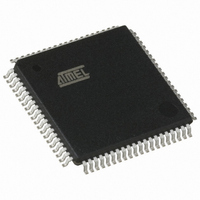AT80C51SND1C-ROTIL Atmel, AT80C51SND1C-ROTIL Datasheet - Page 91

AT80C51SND1C-ROTIL
Manufacturer Part Number
AT80C51SND1C-ROTIL
Description
IC MCU FLASH MP3 DECODER 80-TQFP
Manufacturer
Atmel
Series
80Cr
Datasheet
1.AT80C51SND1C-ROTIL.pdf
(213 pages)
Specifications of AT80C51SND1C-ROTIL
Core Processor
8051
Core Size
8-Bit
Speed
40MHz
Connectivity
I²C, IDE/ATAPI, MMC, SPI, UART/USART, USB
Peripherals
Audio, I²S, MP3, PCM, POR, WDT
Number Of I /o
44
Program Memory Type
ROMless
Ram Size
2.25K x 8
Voltage - Supply (vcc/vdd)
2.7 V ~ 3.3 V
Data Converters
A/D 2x10b
Oscillator Type
Internal
Operating Temperature
-40°C ~ 85°C
Package / Case
80-TQFP, 80-VQFP
Lead Free Status / RoHS Status
Contains lead / RoHS non-compliant
Eeprom Size
-
Program Memory Size
-
Other names
AT80C51SND1CROTIL
Available stocks
Company
Part Number
Manufacturer
Quantity
Price
- Current page: 91 of 213
- Download datasheet (3Mb)
15.5
15.5.1
15.5.2
15.5.3
15.6
15.6.1
4109L–8051–02/08
Control Transactions
Isochronous Transactions
Setup Stage
Data Stage: Control Endpoint Direction
Status Stage
Isochronous OUT Transactions in Standard Mode
The firmware should never write more Bytes than supported by the endpoint FIFO.
The DIR bit in the UEPSTAX register should be at 0.
Receiving Setup packets is the same as receiving Bulk Out packets, except that the RXSETUP
bit in the UEPSTAX register is set by the USB controller instead of the RXOUTB0 bit to indicate
that an Out packet with a Setup PID has been received on the Control endpoint. When the
RXSETUP bit has been set, all the other bits of the UEPSTAX register are cleared and an inter-
rupt is triggered if enabled.
The firmware has to read the Setup request stored in the Control endpoint FIFO before clearing
the RXSETUP bit to free the endpoint FIFO for the next transaction.
The data stage management is similar to Bulk management.
A Control endpoint is managed by the USB controller as a full-duplex endpoint: IN and OUT. All
other endpoint types are managed as half-duplex endpoint: IN or OUT. The firmware has to
specify the control endpoint direction for the data stage using the DIR bit in the UEPSTAX
register.
•
•
To send a STALL handshake, see
The DIR bit in the UEPSTAX register should be reset at 0 for IN and OUT status stage.
The status stage management is similar to Bulk management.
•
•
An endpoint should be first enabled and configured before being able to receive Isochronous
packets.
When an OUT packet is received on an endpoint, the RXOUTB0 bit is set by the USB controller.
This triggers an interrupt if enabled. The firmware has to select the corre Bulk-outsponding end-
point, store the number of data Bytes by reading the UBYCTX register. If the received packet is
If the data stage consists of INs, the firmware has to set the DIR bit in the UEPSTAX register
before writing into the FIFO and sending the data by setting to 1 the TXRDY bit in the
UEPSTAX register. The IN transaction is complete when the TXCMPL has been set by the
hardware. The firmware should clear the TXCMPL bit before any other transaction.
If the data stage consists of OUTs, the firmware has to leave the DIR bit at 0. The RXOUTB0
bit is set by hardware when a new valid packet has been received on the endpoint. The
firmware must read the data stored into the FIFO and then clear the RXOUTB0 bit to reset
the FIFO and to allow the next transaction.
For a Control Write transaction or a No-Data Control transaction, the status stage consists of
a IN Zero Length Packet (see
89). To send a STALL handshake, see
For a Control Read transaction, the status stage consists of a OUT Zero Length Packet (see
“Bulk/Interrupt OUT Transactions in Standard Mode” on page
“Bulk/Interrupt IN Transactions in Standard Mode” on page
“STALL Handshake” on page
“STALL Handshake” on page
AT8xC51SND1C
93.
87).
93.
91
Related parts for AT80C51SND1C-ROTIL
Image
Part Number
Description
Manufacturer
Datasheet
Request
R

Part Number:
Description:
DEV KIT FOR AVR/AVR32
Manufacturer:
Atmel
Datasheet:

Part Number:
Description:
INTERVAL AND WIPE/WASH WIPER CONTROL IC WITH DELAY
Manufacturer:
ATMEL Corporation
Datasheet:

Part Number:
Description:
Low-Voltage Voice-Switched IC for Hands-Free Operation
Manufacturer:
ATMEL Corporation
Datasheet:

Part Number:
Description:
MONOLITHIC INTEGRATED FEATUREPHONE CIRCUIT
Manufacturer:
ATMEL Corporation
Datasheet:

Part Number:
Description:
AM-FM Receiver IC U4255BM-M
Manufacturer:
ATMEL Corporation
Datasheet:

Part Number:
Description:
Monolithic Integrated Feature Phone Circuit
Manufacturer:
ATMEL Corporation
Datasheet:

Part Number:
Description:
Multistandard Video-IF and Quasi Parallel Sound Processing
Manufacturer:
ATMEL Corporation
Datasheet:

Part Number:
Description:
High-performance EE PLD
Manufacturer:
ATMEL Corporation
Datasheet:

Part Number:
Description:
8-bit Flash Microcontroller
Manufacturer:
ATMEL Corporation
Datasheet:

Part Number:
Description:
2-Wire Serial EEPROM
Manufacturer:
ATMEL Corporation
Datasheet:











